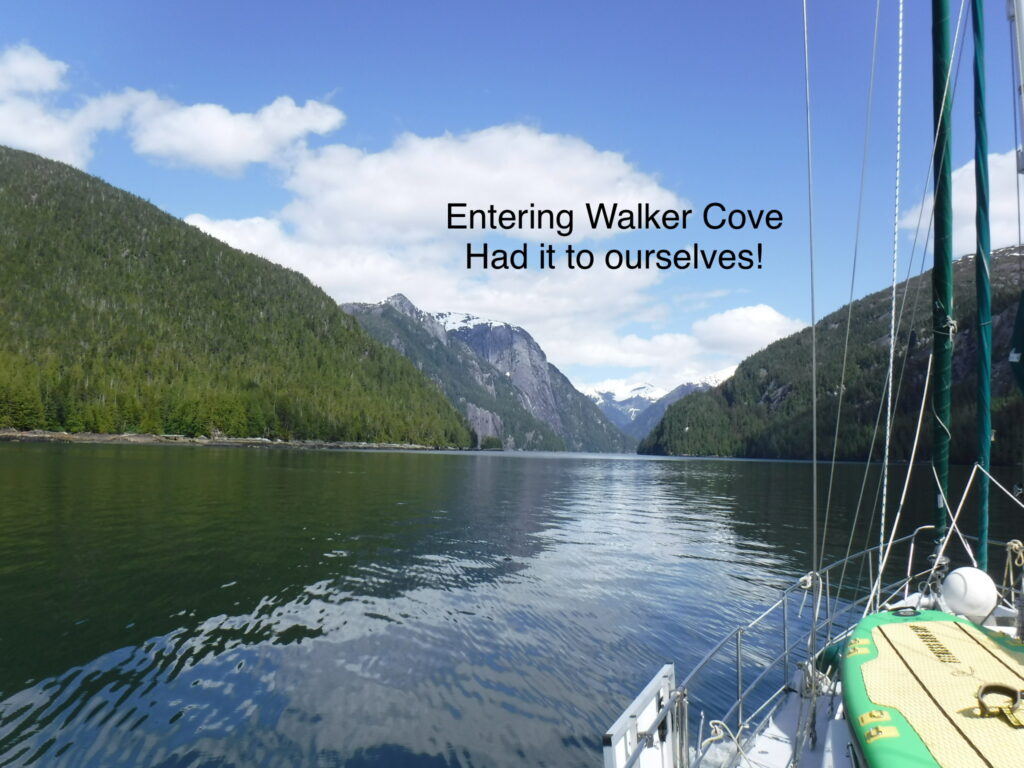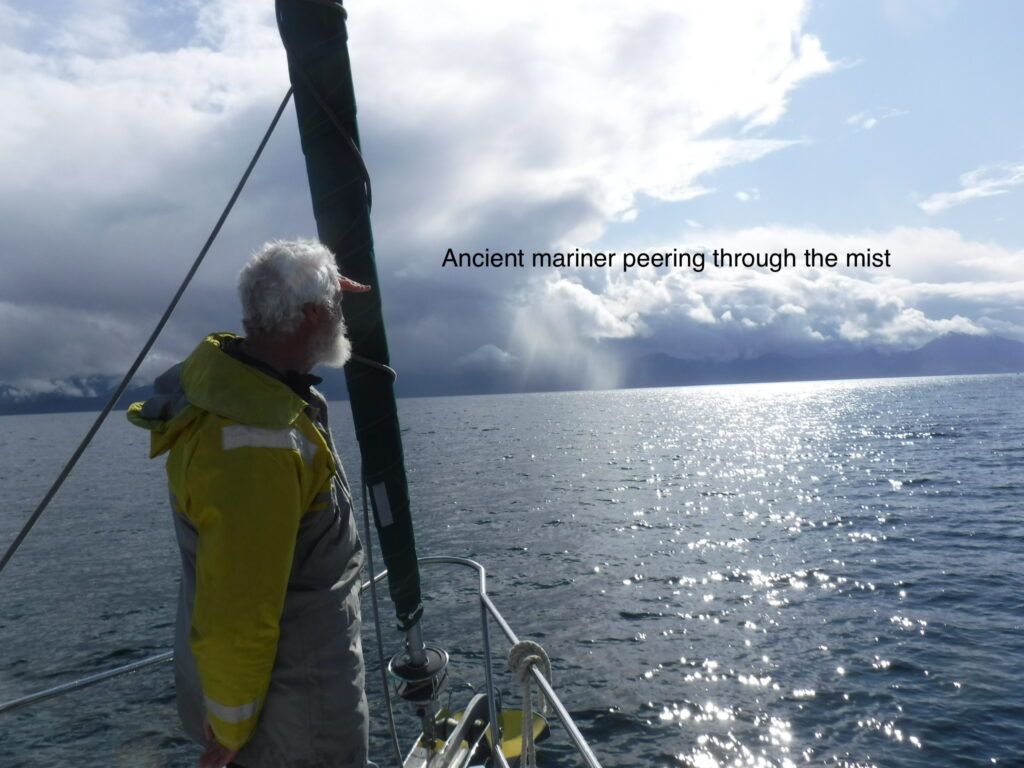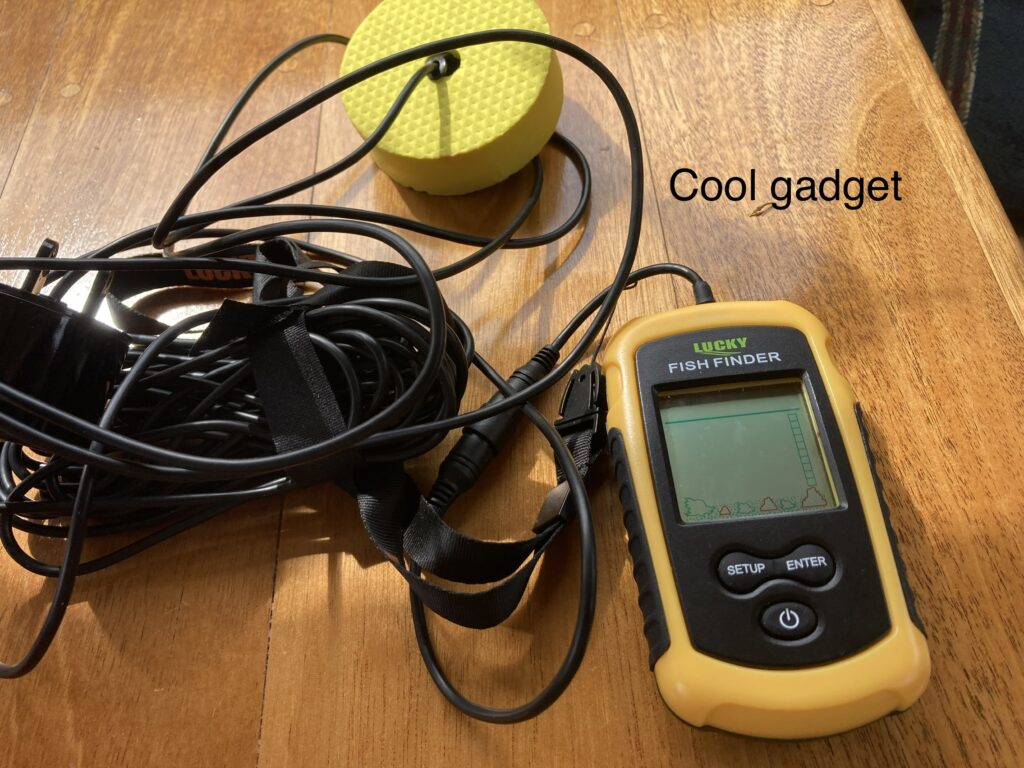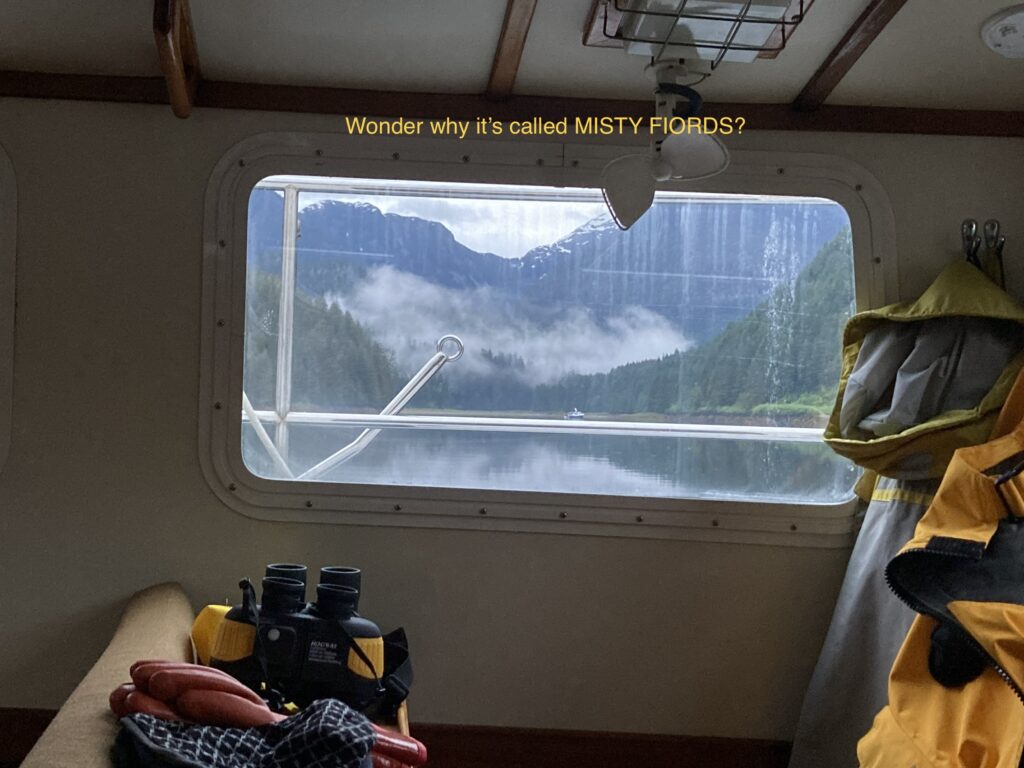Dear friends and family
Post Thorne Bay we re-crossed Clarence Strait and toured the Behm Canal in a clockwise direction. A favorite stop was Klu Bay, which is a very protected, but deep anchorage. Our friends Bill and Donna on denalirose.com were also anchored in there so we went to each other’s boat for dinner alternating nights.Liz and I took a longish walk along an old logging trail and even picnicked on the shore before Bill and Donna warned us about the black bears stalking people and the risks of that. Naïveté wins again in that we weren’t eaten.
There’s a great waterfall near the entrance that you can row right up next to, note our little rowboat in the picture.
After a couple more stops, we found our favorite anchorage of this area: Walker Bay. We had one other boat with us only the first night and the next two nights we were alone. There’s a forest service mooring there, but I have a mistrust of moorings so we found the shallow spot at the mouth of the river to drop our own hook. When I’m in fairly shallow spots like that I have a couple of gadgets that I use to feel more like an adventurer in uncharted waters ( which they are due to the river flow) and safety, as drying out on a low tide wouldn’t be any fun.
- A portable fish finder ($40)that I put in the dinghy and row around what I calculate is the scope of our chain to see the depth and
- A golfing range finder ($20) to point at an object and measure the distance. Then, since I know how much scope (length of chain) I have out, I can see if we could drift to the shallow spots.
We did have to move once this trip as we would have been high and dry at low tide. There wasn’t any other place to anchor that wasn’t too deep, so these tools came in handy.
We spent most of our time in Walker watching the sow with what appeared to be a one year old cub playing on the shore, and the huge brown bear on the other shore turning over boulders looking for treats.
After Walker we headed for an anchorage within close range of Ketchikan, where we were picking up our guest. On the way, we saw Orca whales and humpbacks and we always stop to watch and admire them.
Here’s what I wrote right after we got in to Ketchikan. I thought I’d leave it unedited as it feels more like I did then.
The wind really picked up steadily as we approached the Icey cove to anchor. No AIS signals from inside, but as we drew near we could see a fishing troller with poles extended at anchor there. As we turned to go in, another appeared at anchor behind it. I carefully eased Hongvi in making sure to clear our rig from the anchored outriggers. Not much extra room, but enough. The wind followed us inside and the opening was funneling wind inside. Behind the second boat there just might be more room than at first appeared, there usually is. We even dropped the hook just behind the second boat, but as we let out chain we drifted back to just in front of the mooring and soon we’re drifting down upon it. Nope, bad call. Not enough room. “ Liz, raise the anchor. We are leaving” i bellowed into the wind.
It seemed to take more time than usual to raise 150 feet of chain.I was pleased to get the head pat signal that the hook was above the water and immediately gave throttle to allow more steerage, scooted by the outstretched riggers first and the just at the surface rocks toward open white water. Now clear of the rock hazards, we could talk.
“ it’s about ten miles back to that other anchorage, which would mean an additional ten miles later, or we could go straight to Ketchikan now” I offered.
Liz thought it a good idea to just get in and tied up to give us relaxing time and be safe.
All we had to do was navigate the channel to Ketchikan dodging boats of every shape and size, while heading into a building wind and sea, to try to dock eighteen tons of steel in an unfamiliar place in the wind. Oh boy!
And there was always the probability of no space available. What would we do then? Start thinking of plan D, since we were already on plan C.
Liz called and was able to reserve a slip far inside the marina. As I headed towards the entrance the wind and waves picked up in the outside channel. Then as we got further in less waves, then soon less wind as I found and then drove deeper amongst the mostly fishing boats filling the marina. We spotted our empty slip which would take a tight turn to starboard to approach. I took the turn as wide as possible, clearing our dinghy hanging in the aft davits by only feet from boats behind us. I couldn’t count on the bow thruster working, so turned the wheel over hard, then full throttle quickly to force the stern around with the prop walk. She came around like planned and we were on our way. Turns out that the step down to the floating docks is about a foot longer than normal, so Liz he’d to jump slightly the last step to get on the finger dock. A quick turn on the cleat and the stern was secured, then I ran forward to hand her the bow line and we were safe, secure, undamaged and really, really tired after our ten hour day motoring, anchoring, wind, waves, traffic, fears and docking. Easy peasy 🤪.
After many years cruising, both the “ halfway round the world” cruise in my 30’s plus three seasons in Alaska, my anchoring skills are getting better.
It wasn’t always that way:
The first few stops after leaving Falmouth England in ‘86 were at marinas: Spain mainland, Portugal coast, Madeira Island, but then our last stop before crossing the Atlantic was in La Gomera, one of the smaller Canary Islands. At the time there was only a commercial harbor with a small corner for pleasure boats to anchor.
As we came around the entrance we could see two other boats tucked in, with bow and stern anchors to keep them from drifting into the main channel. I had never anchored this boat as we just took possession of it. I had an idea that I could drop a stern anchor, let it out as I motored forward, carefully squeezing between these tow boats to then drop a bow anchor and back up, letting out the bow anchor chain as I took in the stern chain to end behind the two boats there.
Except: I used up all my bow chain just as I was between the other two boats and was in kind of a pickle. The other boat owners were down below one of the boats, which I recognized from the book I had read VOYAGING ON A SMALL INCOME. Pete and Annie, the authors and Trevor Robertson all popped up when they noticed a new boat stopped within feet of them. I expected expletives and got sympathy. In fact, the first thing Annie said was “ Cool, I’ve been wanting to see these Ebbtide 36 boats that are built in Cornwall and now is my chance”
I guess I accommodated her wish pretty well in that I was only feet away.
They all jumped in their dinghies and helped us two pathetic newbies get safely sorted out.
Then it was time to visit each other’s boats and swap stories.
Both Pete and Annie and Trevor had already sailed a couple of hundred thousand ocean miles.
We met both boats again over the years during our cruise and it turned out that when Pete and Annie divorced ( built and lived on a 27 foot boat together for many years), Annie married Trevor, spent a winter frozen in the ice of Greenland with him in his 34 foot boat, and she now lives in New Zealand and he in the West Indies. Let’s see, close quarters for a long time together…
They could have been jerks and they were very kind. Some of my best cruising memories are of people like that. A real cruising community.







My vicarious life.
Charlie, the total eclipse of darkness will reach us all someday–as the lights go out, you will know that you have lived a fulfilled existence–an amazing life, in touch with the earth, sky and water. Keep sailing on. Your friend Pinto!
Seems awfully close to the bears! Beautiful waterfall. Always some predicament to deal with. Makes it exciting (and tiring).